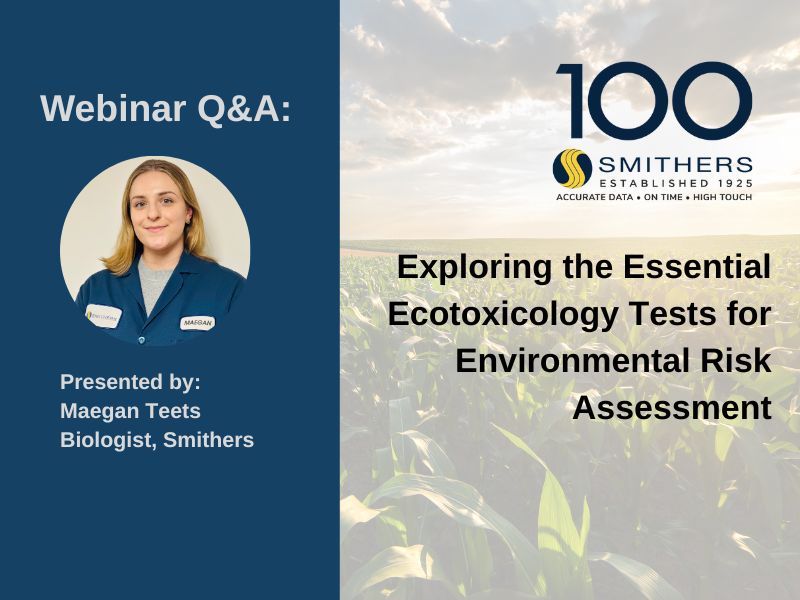Maegan Teets, Biologist, presented the webinar, “
Exploring the Essential Ecotoxicology Tests for Environmental Risk Assessment.” Read below for responses to the questions asked during the audience Q&A.
Q: How many fish/treatment does Smithers typically use for fish acute range-finders?
A: We typically use only one replicate of 3-7 fish for rangefinders, this is usually sufficient to establish a dose response to use to select test concentrations for the definitive exposure.
Q: Are there companies who choose a reduced number of fish for fish acute RFs to reduce the number of vertebrates tested?
A: Yes, reductions can be made through reducing fish per replicate, reducing numbers of replicates, or number of dose levels. An example may be testing three concentrations, each with one replicate of three fish.
Q: What alternative test vessel material does Smithers use if a test substance adsorbs to glass? Stainless steel (w/ or w/o PTFE lining)?
A: We would look to use PFTE or HDPE vessels first. Through experience, alternative materials (teflon and stainless steel) under flow-through conditions do not provide significant improvements over glass to warrant changing test system materials. This can be costly and time consuming.
Q: Are your closed systems for volatile compounds only available for static/static-renewal tests? As in, no flow-through tests can be done with your closed test systems?
A: Smithers has conducted flow-through studies in closed vessels. These systems are challenging to set up and prepare and would only be used if flow-through with open vessels would not be sufficient to maintain exposure concentrations.
Q: Do you use the same guidelines for biological pesticides?
A: For EPA registration, there are specific testing guidelines under OCSPP 885 series guidelines (
Series 885 - Microbial Pesticide Test Guidelines | US EPA). For EU registration, currently OECD guidelines, 200 series (example OECD 202, 203, 213) are required/used but they are recognized as not being fit-for-purpose (duration of exposure is too short for infectivity or pathogenicity to occur). The OCSPP 885 series, even as they are very dated, are more fit-for-purpose in evaluating microbial pest control agents.
Q: If there are declining test substance concentrations, would the time-weighted mean be more appropriate than the geomean? Unless the distribution of the set of measured concentrations to be averaged is positively skewed.
A: Both time-weighted mean and geomean would be appropriate in situations where concentration declines were observed. Geomean would typically be used if you had evenly spaced intervals (e.g. every 24 hours) with a consistent decline in measured concentration over the renewal period), whereas time-weighted mean would be used when you do not have evenly spaced intervals (i.e. at 0-, 24- and 96-hours).
Q: Under what circumstances will a regulator use time-weighted averages to calculate concentrations?
A: Time weighted average is appropriate to use when you have variability in measured concentrations between sampling intervals, and the intervals are not evenly spaced in the study (i.e. at 0-, 24- and 96-hours). This can be applied to both static renewal and flow through studies.
Q: What's the typical price difference between a GLP and a non-GLP test?
A: This will vary based on the scope and test type.
Contact Smithers to discuss your specific needs.
Q: Does Smithers offer testing on macrophytes such as Lemna and Myriophyllum?
A: Yes, we have a significant amount of testing experience with both species. In-house cultures for both species are established and continuously maintained.
Q: Seems like most herbicides would kill the algae. How does that play into registration?
A: Yes, typically herbicides will be more toxic to algae than fish or invertebrates. Often in this case, multiple species of algae will be tested to understand the sensitivity over a range of algal species to support the risk assessment for a compound like this. Sensitivity of the supporting analytical method is an important consideration when testing herbicides with algae as well.
Q: What approaches can be used to ensure the exposure solutions do not contain undissolved material (e.g., emulsion)?
A: There are a variety of approaches that can be used. Filtration, centrifugation and time settling (siphoning dissolved portion of solution) are examples of methods to remove undissolved material from exposure solutions. Other physical properties (e.g., adsorption) will play a role in the method selected for removing undissolved material.
Q: A wonderful presentation especially for one unfamiliar with the details of ecotox testing. Do you ever publish your data? Have you considered using AI modeling to predict any of your your results in advance?
A: Most of the study data Smithers generates is the property of the client we are conducting the testing for. It is up to the client whether they are willing to publish this data or present publicly. There are cases where we publish study data with support of our clients. AI modeling is not currently used, but we do explore a wide variety of data bases for read-across when assessing test approaches.

.jpg?ext=.jpg)
.jpg?ext=.jpg)
-(644-x-350-px).jpg?ext=.jpg)
-(1).jpg?ext=.jpg)